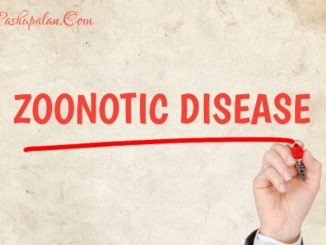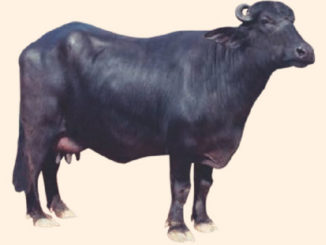Pyometra
It is characterized by the accumulation of purulent or muco-purulent material within the uterine lumen along with distension of the uterus, in the presence of an active corpus luteum. Although there is functional closure of the cervix, the lumen is not always completely occluded and some pus may discharge through the cervix into the lumen of vagina. On U.S.G. pyometra is characterized by a C.L. in an ovary, accumulation of mixed echo- density fluid in the uterine lumen and distension of the uterus.
Diagnosis
It can be based on trans-rectal palpation of a distended uterus and /or trans-rectal ultra-sonography of mixed echogenicity fluid, and the presence of a persistent C.L., with a history of anoestrus.
Treatment
- Best treatment is to use prostaglandin (PGF2α and or its synthetic analogues). Infection (s) because of presence of a persistent corpus luteum.
- Due to common relapse it is recommended to repeat the prostaglandin treatment 12 to 14 days later.
- Intrauterine antibiotic therapy (cephapirin) may be used as well. (Metricef ® Intervet each syringe of metricef intrauterine suspension contains 500mg of cephapirin (as benzathine).
- One treatment with metricef is generally sufficient for complete cure). If necessary, treatment can be repeated after 14 days complete restoration of the endometrium may need 4 to 8 weeks hence it is very crucial to diagnose and treat pyometra as soon as possible after calving to decrease the destruction of the endometrium due to pyometra.
Endometritis
It is the inflammation of the endometrium of the uterus. It may be clinical or sub-clinical.
- It has profound effect on the fertility of animal though it does not affect the general health.
- Presence of a white or whitish yellow muco-purulent vaginal discharge is the most common clinical sign of the endometritis
- Volume of discharge is variable but increases at the time of oestrous, when the cervix dilates and there is copious vaginal mucous.
- The clinical signs of endometritis often can not be demonstrated by rectal or vaginal examination. In more severe cases there may be a mucopurulent discharge from the uterus.
- It is difficult to rule out the source of flakes clinically as they may came from vagina, cervix or uterus.
- Presence of flakes of pus in the estrual mucus may indicate endometritis.
- Often estrual mucus may be cloudy or milky instead of clear or transparent and contain more leucocytes.
- Cervical mucus in bovines during pro-estrous may normally be slightly cloudy.
- In many cases a mild to moderate cervicitis may be evident with an endometritis or be secondary to it due to contamination from the uterus.
- On rectal palpation uterus may occasionally feel slightly enlarged, heavy, and thick walled (tortous).
- Failure of normal, prompt involution of uterus may leads to chronic endometritis and uterine infection.
- Diagnosis on the basis of rectal examination is not reliable.
- The estrus cycle and periods are usually normal in length but occasionally cycles may be shortened to 8 to 12 days due to acute endometrial inflammation preventing the development of a normal corpus luteum. The fertilized ovum may die due to abnormal endometrium and infection in the uterus and the cow again comes into estrum.
- The estrous cycle may vary in length in some cases due to early embryonic death and maceration of embryo as in Trichomoniasis, Campylobacteriosis, and other infections. Long cycles may follow service and be due to early embryonic deaths.
- Repeated services and failure to conception are common symptoms of endometritis
- Estrus cycle may be regular or irregular
Etiology
- In majority of cases, endometritis and metritis is due to infection, the severity of condition being related to the virulence of the organisms involved.
- Various factors predispose the uterus to infection and these includes wounds on uterine mucosa, dystocia, and or faulty obstetrical operations, abortions, retained fetal membranes, twin births, premature birth, uterine inertia, lack of exercise, delayed involution, crude methods of treatment, injuries during inseminations and unhygienic conditions at the time of insemination and parturition.
- In severe cases of pneumo-vagina the faeces and urine aspirated to the anterior vagina, leads to cervicitis and endometritis.
- Nutritional deficiencies, unbalanced rations such as excess of potassium fodder and exposure to wet and cold may lower the resistence and predispose to infections.
- Hormonal imbalance such as excess of estrogens may give rise to cystic form of endometritis.
- Natural services with infected bull with venereal diseases due to transmission of organisms from the sheath or semen. The natural defenses against infection during estrus help the cow to overcome this huge infection.
- Improper sterilization of A.I. equipments and unhygienic method of A.I. may leads to endometritis.
- More specific pathogenic organisms includes Br. Abortus, Campylobacter fetus, and Trichomonas fetus. Other organisms includes, Mycobacterium tuberculosis, Proteus spp , Pseudomonas aeruginosa, and IBR-IPV virus etc.
Specific pathogens: Develop without predisposing cause.
Nonspecific infections: Requires a predisposing cause and tend to affect individual cow. This group is more important cause.
Opportunist pathogens: Streptococcus, Staphylococcus, Actinomyces pyogenes (Corynebacterium pyogenes) and E. coli alone or as mixed infection, fungi etc.
Diagnosis
- Tentative diagnosis is based on history and clinical signs but confirmed by bacteriological and histological examination.
- Most common lesions observed in cattle were exudation, or periglandular fibrosis with leucocytic infiltration and subsequent glandular degeneration and dilation.
Whiteside Test
It can be used for diagnosis of endometritis in field conditions:
- Collection of cervical mucus aseptically from repeat breeder cow or buffaloes.
- 1 ml of cervical mucus transferred in to sterile test tube and add 1 ml of 5 % sodium hydroxide solution in to it.
- The mixture should be heated to boiling temperature for 2-3 minutes.
- If the colour of mixture turned yellow it would be considered as positive for endometritis.
Prognosis
In most of the cases is fair to good, with every estrus cycle, the immunity achieved by the animal and the changes that occur in the organs, and the action of estrogens tend to help recovery. More severe cases requires more longer time for recovery. Prior to complete recovery, breeding of animals may result in embryonic death, abortion or premature birth.
Principle of Treatment
An ideal treatment for uterine infection should:
- Eliminates bacteria from the uterus.
- Not inhibits the normal uterine defense mechanism.
- No drug residues should be excreted in milk or should be left in meat.
The general principal of therapy for management of endometritis is to halt and reverse inflammatory changes that impair fertility. The aim of treatment should be to reduce the load of pathogenic bacteria and enhance the processes of uterine defense and repair.
Following factors to be considered while selecting antimicrobials are:
- The uterine environment
- The pathogen
- Route of administration of the antimicrobial.
- Severity of irritation caused by the antimicrobial agent or vehicle, the antimicrobial and or carrier agent used for the intrauterine therapy, treatment economics and outcome of therapy. Antimicrobials as well as vehicles used to carry the antimicrobials vary in the severity of irritation.
Antibiotics
Intrauterine infusions of antimicrobials Now a days various preparations administered routinely in to the bovine uterus are detrimental to uterine tissue.
Effectiveness of therapeutic efforts are complicated by development of resistant bacterial strains due to indiscriminate use of antibiotics. Therefore, proper selection of antibiotics and its doses preventing development of resistant strains of microbes and to eliminate infection as quickly as possible is also important.
For effective antimicrobial therapy, effective concentration of the drug must be achieved and maintained at the site of infection for an adequate period.
For treatment of genital infections two main routes of administration used are local (intrauterine) and systemic (intramuscular or intravenous).
Gentamicin has good effect on uterine pathogens and provides effective antibiotic cover when administered twice a day.
Those antibiotics which are ineffective in anaerobic environment like aminoglycosides, should not be used in postpartum intrauterine infections.
Acidic drugs are comparatively better absorbed than the basic drugs because pH of the infected uterus tends to be acidic.
The absorption of the drug from the uterus is also influenced by the stage of the involution.
Absorption of Penicillin, Streptomycin and Oxytetracycline is relatively poor during immediate postpartum period as compared to absorption from the involuted uterus.
Pathological changes of uterus further decreases the absorption, resulting in a high concentration of drug in the uterine cavity.
Intrauterine route having several disadvantages viz. repeated infusion is inconvenient, traumatic, and sometimes the drug can be expelled out along with the exudates.
Systemic administration of antimicrobial agents gives a better distribution in the tubular genital tract. The desirable tissue concentrations of antibiotic are achieved in the endometrium following intravenous or intramuscular administration.
Parental administration of aminoglycosides proves more effective since its effectiveness is markedly reduced in presence of pus or blood in the uterine cavity.
Oxytetracycline by parental route also provides adequate tissue concentration levels.
The abnormal exudates can not mechanically influence the distribution and repeated treatment can be carried out without the entry of new pathogens. Moreover therapy can be carried out at any time irrespective of the stage of estrus cycle.
Non Antibiotic therapy
Antiseptics like Lugol’s iodine infusion is usually recommended as first choice in cases without a clear cut diagnosis of uterine infection. When used in a nondeliterious concentration, lugol’s iodine has an additional advantage that it can serve as an ideal substitute for antifungal drugs. Use of antiseptics in too high concentrations leads to endometrial damage, which delays conception, although the clinical signs may often resolve.
Infusion of irritants in to uterus with diseased endometrium may adversely affect fertility. Moreover, the drainage of such substances may also predispose animal to salpingitis or ovaro-bursal adhesions, when infused in large quantities.
Indeed, following specific use of antiseptics in the cow that has failed to respond to repeated standard treatments; presumably the antiseptic acts as a chemical curettage for the endometrium, there is subsequent regeneration.
Hormones
Administration of PGF2α is the treatment of choice for animals whose ovary having a corpus luteum. PGF2α induce luteolysis followed by induction of estrus which increases mucous outflow from the uterus, increases uterine myometrial tone and to enhance the immune defense mechanisms.
PGF2α works in three ways:
- Induce luteolysis and bring the animal into estrum, thus removing the suppressive effect of progesterone on the uterine defense mechanism or alternatively, stimulate it through estrogen.
- Stimulates myometrial contractions which may leads to expel debris and microorganisms that contaminate the uterine lumen after calving.
- It may have stimulatory effect on the phagocytic activity of uterine polymorphonuclear granulocytes.
However, in absence of a C.L. PGF2α is a less effective therapy for endometritis, but may still exert some action on the uterus.
Antimicrobials are a more logical treatment for those animals that don’t have a C.L.
Intramuscular injection of small doses of estradiol benzoate is likely to be a good treatment for endometritis if C.L. can not be palpated, whereas high doses of estrogen may lead to impaired L.H. functions.
Estrogen alone or in combination with oxytocin can be used as a therapy for endometritis.
Local or systemic administration of estrogen alone or in combination with antibiotic is seldom used as the appreciable levels have been detected in milk.
Line of treatment
- Sexual rest for 2-3 cycles.
- Antibiotic based on ABST.
- Prostaglandin injection during mid-luteal phase i.e. 10-12 days after estrus.
- Combination of antibiotics and prostaglandins.
- Treatment with immuno-modulaters and E.coli polysaccharides @100µg in 30 ml of P.B.S. solution
- Levamisole S/C @ 2.5 mg on day 0.2, 6.8, 10, 14 and 18 of the estrus cycle.
- Oyster glycogen-1% in 30-60 ml PBS.
- EDTA+Tris-3.5 mmol.
- Autologous plasma @50 ml I/U for 3 days.
- Leucotriene B4 @ 50 ml of 0.30 nmol /litre.
- Peracetic acid 0.2% of 30 ml.
Reference
- Veterinary Reproduction and Obstetrics Tenth edition(2019) . David E. Noakes, Timothy J. Parkinson and Gary C. W. England.
- Diagnosis and Treatment of Reproductive Disorders in Dairy Cows(Theriogenology-I) First edition (1994) Dr. V. N. Viswanatha Reddy.
| The content of the articles are accurate and true to the best of the author’s knowledge. It is not meant to substitute for diagnosis, prognosis, treatment, prescription, or formal and individualized advice from a veterinary medical professional. Animals exhibiting signs and symptoms of distress should be seen by a veterinarian immediately. |






1 Trackback / Pingback